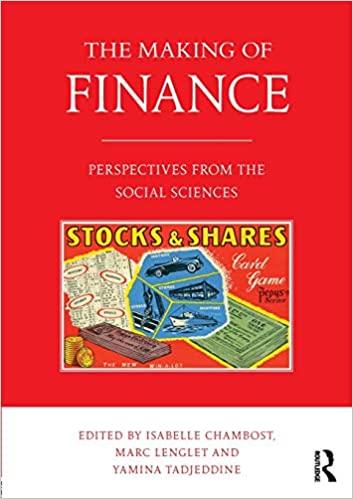Question
Your first assignment in your new position as assistant financial analyst at Caledonia Products is to evaluate two new capital-budgeting proposals. Because this is your
Your first assignment in your new position as assistant financial analyst at Caledonia Products is to evaluate two new capital-budgeting proposals. Because this is your first assignment, you have been asked not only to provide a recommendation but also to respond to a number of questions aimed at assessing your understanding of the capital-budgeting process. This is a standard procedure for all new financial analysts at Caledonia, and it will serve to determine whether you are moved directly into the capital-budgeting analysis department or are provided with remedial training. The memorandum you received outlining your assignment follows:
To: The New Financial Analysts From: Mr. V. Morrison, CEO, Caledonia Products Re: Capital-Budgeting Analysis
Provide an evaluation of two proposed projects, both with 5-year expected lives and identical initial outlays of $110,000. Both of these projects involve additions to Caledonias highly successful Avalon product line, and as a result, the required rate of return on both projects has been established at 12 percent. The expected free cash flows from each project are as follows:
|
| Project A | Project B |
|
| Initial outlay | -$110,000 | -$110,000 |
|
| Inflow year 1 | 20,000 | 40,000 |
|
| Inflow year 2 | 30,000 | 40,000 |
|
| Inflow year 3 | 40,000 | 40,000 |
|
| Inflow year 4 | 50,000 | 40,000 |
|
| Inflow year 5 | 70,000 | 40,000 |
|
In evaluating these projects, please respond to the following questions. For questions from (a) to (j) assume that the projects are independent. That is both could be accepted if both are acceptable. a. What is the payback period on each project? If Caledonia imposes a 3-year maximum acceptable payback period, which of these projects should be accepted? b. What are the criticisms of the payback period? c. Determine the NPV for each of these projects. Should they be accepted? d. Describe the logic behind the NPV. e. Determine the PI for each of these projects. Should they be accepted? f. Would you expect the NPV and PI methods to give consistent accept/reject decisions? Why or why not? g. Determine the IRR for each project. Should they be accepted? h. What reinvestment rate assumptions are implicitly made by the NPV and IRR methods? Which one is better? i. Determine the MIRR for each project. Should they be accepted? j. Describe the logic behind the MIRR. k. Rank the two project based on all above criteria and make a recommendation as to which (if either) should be accepted under the assumption that the projects are mutually exclusive. l. Caledonia is considering two additional mutually exclusive projects. The free cash flows associated with these projects are as follows:
|
| Project A | Project B |
|
| Initial outlay | -$100,000 | -$100,000 |
|
| Inflow year 1 | 32,000 | 0 |
|
| Inflow year 2 | 32,000 | 0 |
|
| Inflow year 3 | 32,000 | 0 |
|
| Inflow year 4 | 32,000 | 0 |
|
| Inflow year 5 | 32,000 | 200,000 |
|
The required rate of return on these projects is 11 percent. 1. What is each projects payback period? 2. What is each projects NPV? 3. What is each projects IRR? 4. What has caused the ranking conflict? 5. Which project should be accepted? Why?
I ONLY NEED TO DO PART l. (the last question) I need to answer questions 1-5
Step by Step Solution
There are 3 Steps involved in it
Step: 1

Get Instant Access to Expert-Tailored Solutions
See step-by-step solutions with expert insights and AI powered tools for academic success
Step: 2

Step: 3

Ace Your Homework with AI
Get the answers you need in no time with our AI-driven, step-by-step assistance
Get Started


